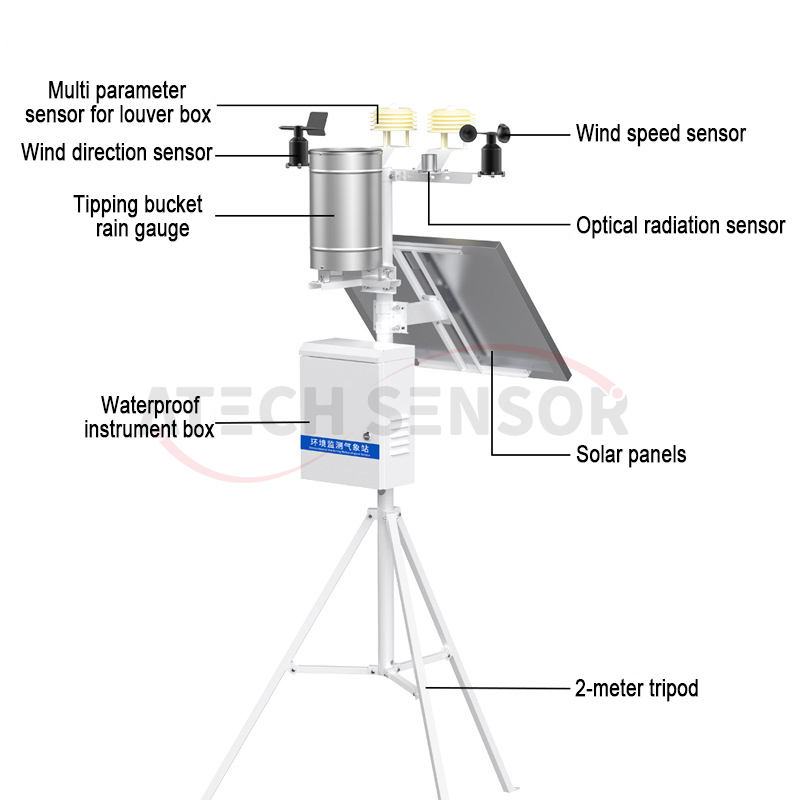What is an Automatic Weather Station (AWS)?
As climate change and extreme weather events become more frequent, AWS has become essential in various fields such as agriculture, water conservancy, environmental protection, transportation, energy, and scientific research. It is particularly useful in areas like remote mountains, uninhabited zones, farmland, forests, and reservoirs where personnel presence is difficult.
Working Principle of an Automatic Weather Station
Core Components of an AWS
1. Weather Sensor Module
Used to monitor various meteorological parameters, including:
• Air Temperature and Humidity Sensor: Monitors atmospheric temperature and relative humidity.
• Atmospheric Pressure Sensor: Provides atmospheric pressure data for weather trend analysis.
• Rainfall Sensor: Measures rainfall intensity and total precipitation.
• Solar Radiation Sensor: Assesses light intensity, used in agriculture and photovoltaic systems.
• Evaporation Sensor (optional): Calculates surface water evaporation.
• Soil Temperature and Humidity Sensor (expandable): Used in agriculture and water irrigation systems.
• Additional parameters: PM2.5, PM10, CO2, snow sensors, noise, or light intensity (depending on the model).
2. Data Logger (Data Acquisition and Control Host)
Responsible for:
• Real-time reading of sensor data.
• Linearization, calibration, and quality control of the data.
• Storing historical data.
• Controlling data acquisition frequency, intervals, and reporting.
3. Communication Module
Supports various data transmission methods:
• Cellular networks: 3G/4G/5G
• LoRa or NB-IoT (long-range low-power)
• Satellite communication (for extremely remote areas)
• Wi-Fi or wired connections (for fixed stations)
4. Power Supply System
• Solar panels + lithium batteries (most common).
• AC mains electricity (for urban meteorological stations).
• Backup batteries (for power failure protection).
5. Support and Protection Systems
• Meteorological-grade supports that meet sensor height standards.
• All-weather protective enclosures that are waterproof, lightning-proof, and dust-proof.
• Radiation protection ventilation covers for temperature and humidity sensors to ensure accurate readings.

Key Features and Technical Advantages of AWS
1. Real-Time Multi-Parameter Monitoring
AWS can monitor more than 10 weather parameters simultaneously, such as temperature, humidity, pressure, wind speed, wind direction, precipitation, solar radiation, and more. Some models also support extended parameters like PM2.5 and noise. High-precision sensors meet international meteorological organization standards to ensure reliable data.
2. Efficient Wireless Data Transmission
With 4G, 5G, Wi-Fi, LoRa, or satellite communication, data can be uploaded in real-time to the cloud, maintaining stable connectivity even in remote areas. Users can access real-time and historical data via mobile apps, web pages, or dedicated software, supporting remote monitoring and decision-making.
3. Intelligent Alerts and Notifications
Built-in algorithms can detect abnormal weather events (such as heavy rain, strong winds, or frost) and send alerts via SMS, app push notifications, or email. For example, a rain alert can pause agricultural irrigation to save resources, while a frost warning can prompt frost protection measures.
4. Low Power Consumption and Easy Maintenance
Solar-powered and low-power design ensures long-term operation, with a modular structure for easy sensor replacement and upgrades. The protective shell is durable against harsh weather conditions, reducing maintenance costs.
5. Data Storage and Analysis
Built-in storage modules preserve historical data to prevent data loss due to network interruptions. Some systems offer basic analysis, generating trend charts or weather reports to support scientific decision-making.
Compared to traditional wired weather stations, AWS eliminates complex wiring, offers flexible deployment, and is suitable for applications in farmland, mountains, coastal areas, or urban environments. Its low power design and rugged protective shell ensure long-term stability in harsh conditions, making it a core part of meteorological monitoring, agriculture, transportation, and energy sectors.
Application Areas of AWS
1. Agriculture and Irrigation Management
• Precise determination of crop water requirements.
• Smart irrigation systems with soil sensors.
• Preventing the impact of extreme weather on crops (frost, heat, drought).
AWS provides rainfall, temperature, humidity, and solar radiation data to optimize irrigation and fertilization schedules. For instance, rainfall data can prevent unnecessary irrigation, saving water resources, while frost alerts can protect orchards and vineyards.
2. Water Resources and Hydrological Management
• Real-time monitoring of rainfall distribution in watersheds.
• Guidance for reservoir dispatch and irrigation plans.
• Key component of flood warning systems.
3. Climate Research
• Supports long-term ecological and climate change trend analysis.
• Used in forest fire risk monitoring, desertification studies, and more.
4. Traffic and Urban Meteorology
• Real-time weather warning systems for highways and airports.
• Urban microclimate monitoring and smart city data support.
AWS monitors visibility, road surface slipperiness, and strong winds to provide alerts for roads, bridges, and airports. For example, AWS on coastal highways can report storm information to ensure driving safety.
5. Renewable Energy and Photovoltaic Industry
• Real-time monitoring of solar radiation and wind energy resources.
• Optimizing operations of photovoltaic power plants and wind farms.
Wind speed, wind direction, and solar radiation data help in site selection and operational strategies for wind and solar energy projects.
6. Environmental Monitoring
• Monitors PM2.5, PM10, and noise levels for urban air quality management and forest fire prevention.
• Real-time monitoring of wind speed and humidity to assess fire risks and deploy preventive measures.
7. Scientific Research and Education
AWS provides high-precision data for climate change research, atmospheric modeling, and educational experiments. Its portability makes it ideal for field studies, helping students understand meteorological principles.
Why Choose NiuBoL Automatic Weather Stations?
• Supports multiple data communication protocols and platform integration (customizable).
• Modular structure for easy maintenance and upgrades.
• Global technical support and customized integration services.
• Rich project experience, exported to over 60 countries or regions.
Conclusion

